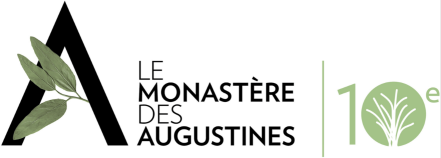Hôpital général de Québec: Stabilizing a Perimeter from the Past
In honour of Archeology Month 2019, Le Monastère des Augustines would like to introduce you to a construction site which is the object of heightened archeological vigilance: the Hôpital général de Québec.
The site, where the extensive work is taking place, has a high prehistoric archeological potential. Furthermore, the active Euro-Canadian occupation, which started in 1619, justifies the presence of an archeologist during the excavation process. Located in Québec’s Lower Town, the wall around the Hôpital général de Québec is being restored. The wall runs along the rue des Commissaires West, and is 278.5 m long, 3.5 m high on average, and 600 mm thick. What was its original use, and why is it important from a heritage perspective? What is the project, estimated at $2,599,797, all about, and why was it undertaken? Find out here.
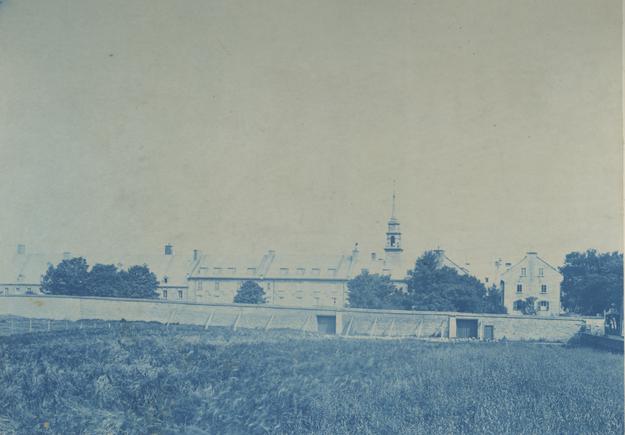
Fonds du Monastère des Augustines de l’Hôpital général de Québec (HG-A-26.23.3.1.2)
© Archives du Monastère des Augustines
In the beginning
We find the reason behind these visual barriers in the solemn vows taken by the nuns before 1965. Three wishes (chastity, poverty, and obedience), which were respected in perpetual cloister. The cloister defined the area where the sisters should neither be seen nor heard by the outside world, other than in visiting rooms, where a grating separated the nun from her visitor:
“The absolute cloister includes all the monastery’s regular locations: the choir, community room, noviciate room, dormitories and cells, kitchen; all the indoor areas like the basements, attics, etc., and outdoor areas, like the garden surrounded by a cloister wall[1]”.
The Mother superior had to obtain a special permission from the bishop to admit people from the outside, whose services were necessary, into the cloister.
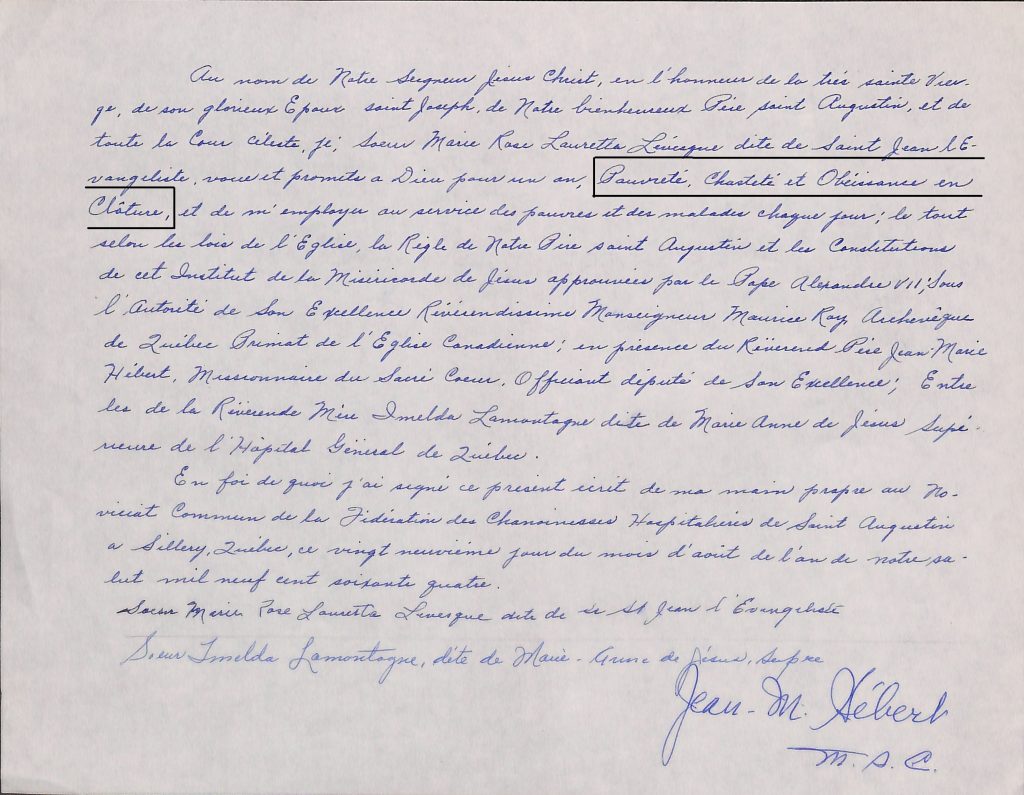
Fonds Monastère des Augustines de l’Hôpital général de Québec (HG-A-14.285)
© Archives du Monastère des Augustines
Furthermore, “the cloister wall will be twelve or fifteen feet tall; trellis can be put against the walls, but we should be wary of planting trees near it, as their height and strength may prove to break the cloister[2]”. The height of the wall and the trees that rose above it helped hide the view the population would have had into the community’s building windows and gardens, as “it is prohibited for the sisters to come close enough to the windows that they may be recognized by people outside the cloister. It is also prohibited to speak or make signs at them through the windows[3]”.
In 1965, the Second Vatican Council abolished the cloister, putting an end to the ancient practice. The wall is therefore important from a heritage perspective, as it is the only visible outside trace of the convent cloister. It is also part of historical site classified in 1977 in virtue of the Loi sur le patrimoine culturel (“cultural heritage law”).
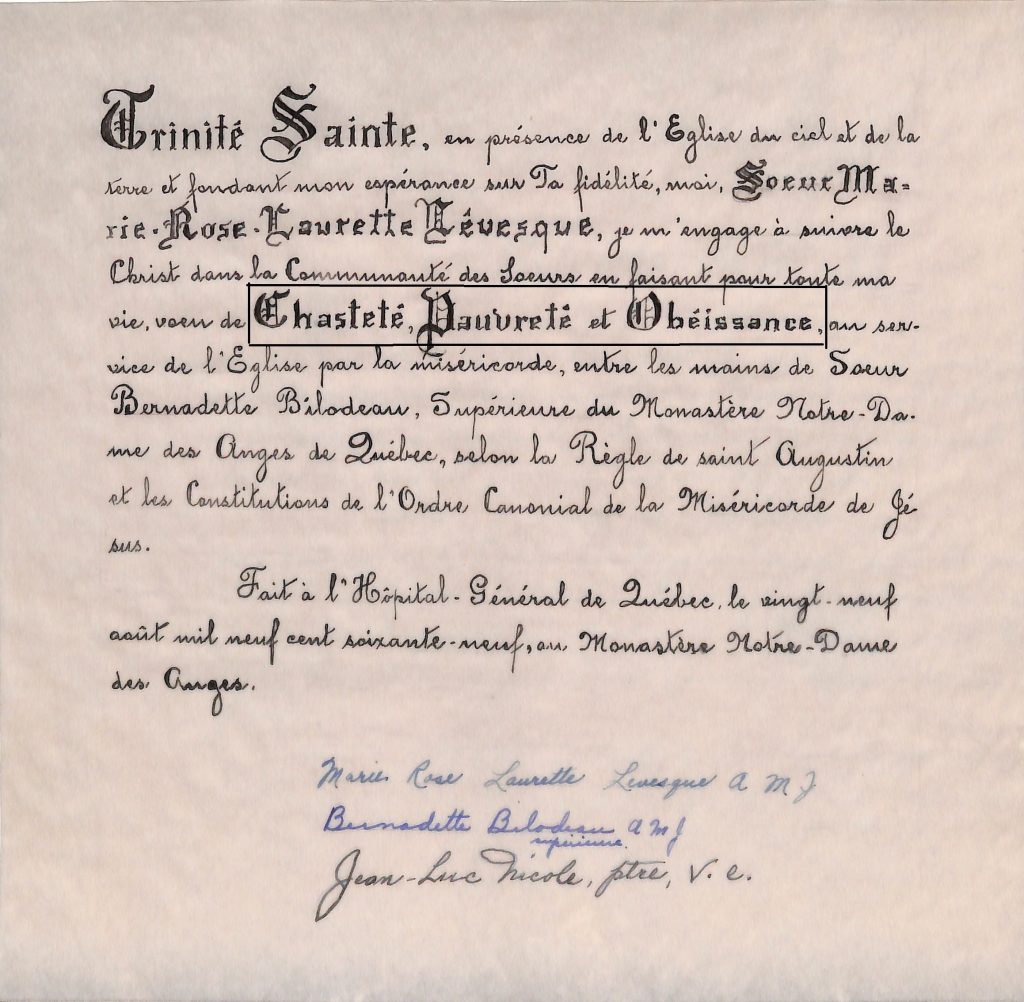
Fonds Monastère des Augustines de l’Hôpital général de Québec (HG-A-14.285)
© Archives du Monastère des Augustines
The situation
A wooden wall was first erected as soon as the Récollets buildings and land were acquired by Monseigneur de Saint-Vallier in 1692. The garden walls, made from round cedar wood stakes, were apparently dismantled during war time, before being reconstructed only at the end of the 18th century[4]. Fires near the monastery destroyed its wooden fences, which led to favor stone as a material in the middle of the 19th century. In February 2016, an evaluation of the state of the wall was undertaken, and the urgent need for an intervention observed.
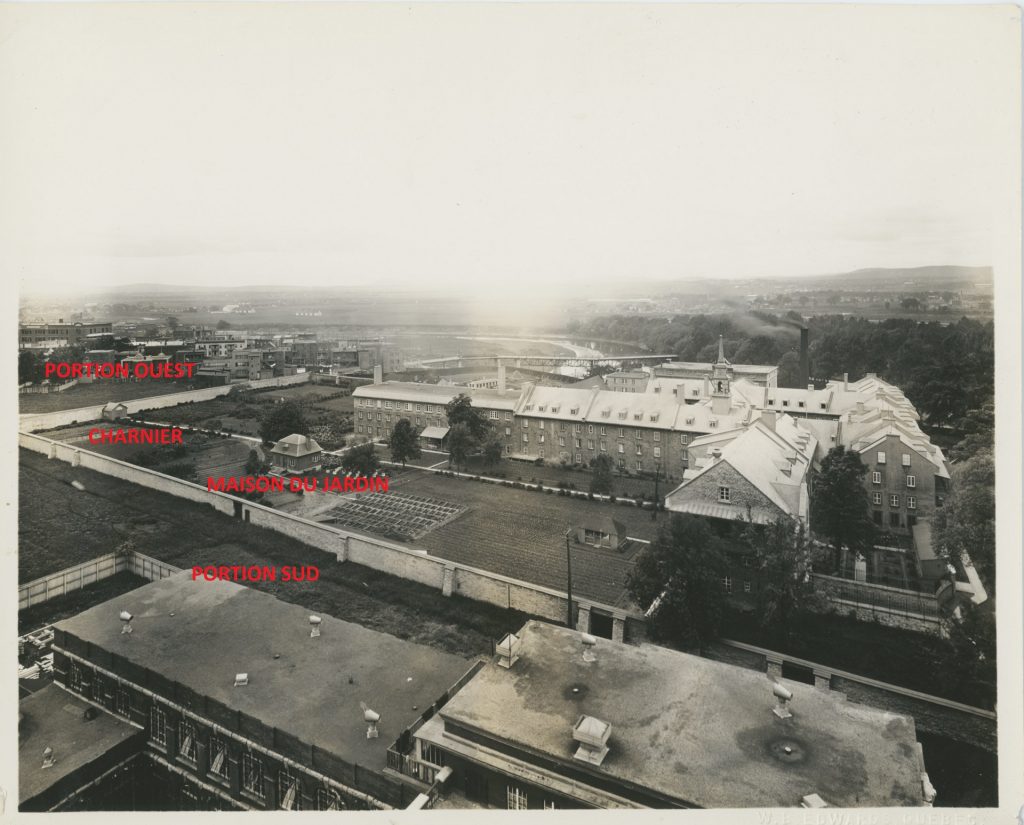
Fonds Monastère des Augustines de l’Hôpital général de Québec (HG-A-26.22.11.1.3)
© Archives du Monastère des Augustines
The goal of the reconstruction work is to secure the location and avoid any unfortunate incidents. The outdoor structure, which is of a venerable age, presents marked signs of deterioration, such as the tops of the walls tilting inward on the southern portion, and outward on western portion. Humidity in the masonry, combined with degradation of the mortar, led to the presence of cracks, and the detachment of a few masonry elements. Some of the buttresses used to solidify the structure have detached from the wall, no longer fulfilling their role.

An engineering consulting firm specializing in the restoration of heritage buildings was mandated by the Saint-Augustin monastery to produce an evaluation of the scope of work needed and costs it would entail, as well as to prepare the necessary plans and quotes. As a first step, the engineers carried out visual and laser surveys. They also planned geotechnical surveys and exploratory openings, which helped them learn more about the state of the different components.
A geotechnical study was undertaken on four predetermined areas in August 2016. These major excavations, carried out on the northern side of the wall, were documented by an archeologist on location. No artifacts were found, but a stone vestige was discovered in the southern part of the wall, near the garden house. More detailed documentation and a deeper dig would allow to identify the vestige and possibly link it to the foundations of an old barn and stable dating back to 1739[5].
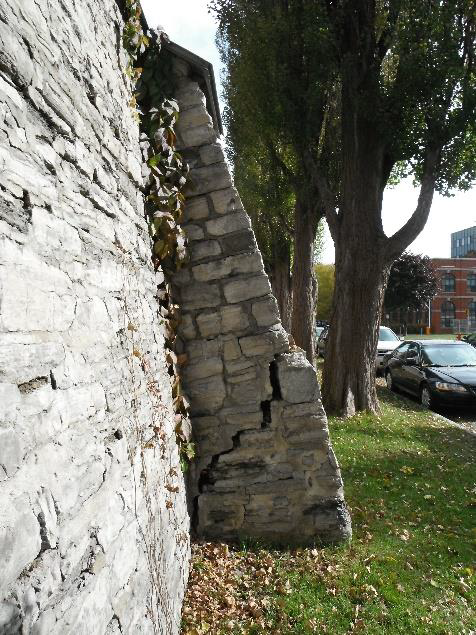
Financing and undertaking the work
After carrying out the studies, plans and quotes were produced, and the final cost of the project determined. A grant request to the Fonds des Petites Collectivités, under the Infrastructure collectives section, was sent in March 2017. The Notre-Dame-des-Anges parish, recognized as a municipality, cannot collect land taxes because the monastery and accommodation centre are exempt from tax payment in virtue of article 204 of the law on municipal taxation[6]. The Augustinian Sisters do not benefit from any incoming funds to compensate the expenses linked to maintaining property assets, and could not have financed the project on their own. In May 2018, the Saint-Augustin monastery’s superior received confirmation of a $2,599,797 grant split into three equal parts between the provincial and federal governments, as well as the Notre-Dame-des-Anges municipality.


WSP, Boundary wall and masonry work: typical cross sections, March 27, 2019, leaflet no 08.
©Monastère Saint-Augustin
The next step was a request for proposals (a call for tenders) from contractors specializing in this type of work, and then selecting the contractor whose submission was the lowest while being compliant. Many steps happened simultaneously, but here is a summary of how the project is being carried out. It all started with cutting down and clearing the stumps of the trees along the outer side of the wall. The poplars needed to be removed, as they presented signs of weakening according to the City of Québec. Oak trees with a similar appearance will be planted towards the end of the project.
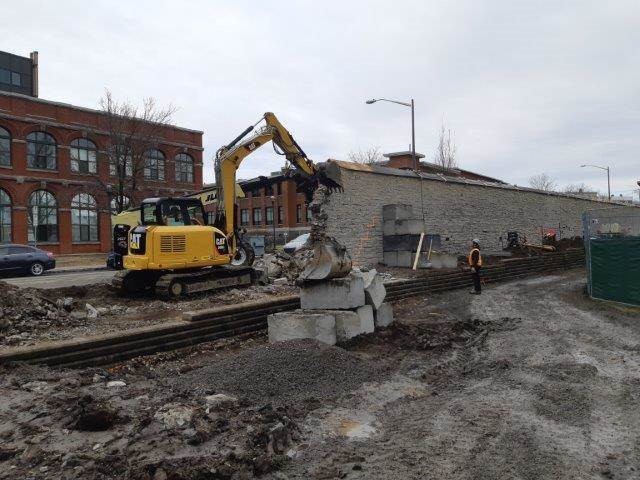
WSP, Visit report, May 2, 2019
Some of the more damaged parts of the wall had to be demolished. The foundations were then redone using reinforced concrete. The part above ground was reconstructed with materials “similar to the original ones, like stone rubble and a squared limestone facing[7]”.
Where the structure is still viable, the siding is restored by emptying the joints and removing individual stones. A partial excavation is performed to restore part of the masonry which touches the ground. Disassembly is carried out in a sequential manner for safety, as well as to preserve the wall’s authenticity. Shoring allows to hold the structure in place when large spaces are created in the reworked surface. Certain stones are salvaged, and other new ones are rejointed, followed by a moist cure to allow the mortar to solidify slowly and avoid cracks. Eventually, things will be finalized by cleaning everything up to inspect the quality of the work.
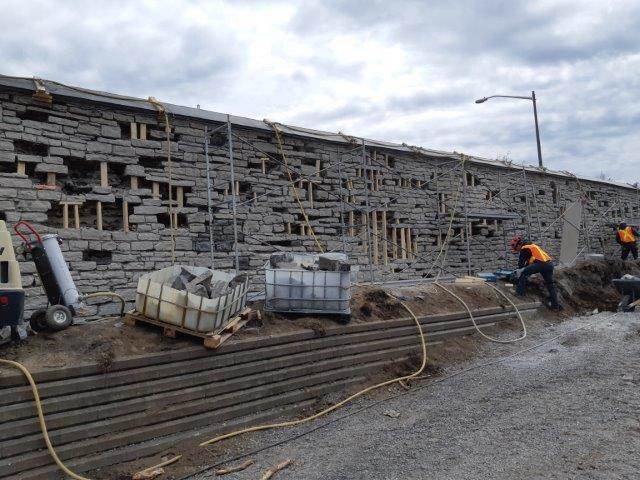
WSP, Visit report, May 14, 2019
Archeological discoveries to come
The goal is to first finish work on the southern portion of the wall, up until the ossuary on the western wall. The project will be suspended around October 2019, to be continued in summer 2020, when the remaining western portion will be completed.
On average, over 15 workers have been working daily on the different restoration operations, not to mention the presence of an archeologist on site. While awaiting his observations, the City of Québec offered guided tours—during Archeology Month—of the exploratory excavations around the grounds of the Hôpital general.
The author would like to thank Ms. Mélanie Tremblay, engineer, and director of buildings and material resources for the Fédération des Augustines, as well as Mr. Éric Therrien, engineer and team leader – Heritage projects at WSP, for their precious and generous help writing this article.
To find out more, please visit the Hôpital général de Québec monastery’s website.
***
[1] Règlements des religieuses hospitalières de la miséricorde de Jésus – Monastère Notre Dame des Anges, Hôpital général de Québec, Chapter V : De la clôture, Article 1 : De la clôture absolue, point 2, p. 26. HG-A-13.12.1.3.1. © Monastère des Augustines Archives, Monastère des Augustines de l’Hôpital général de Québec Fonds.
[2] Règlements des religieuses hospitalières de la miséricorde de Jésus – Monastère Notre Dame des Anges, Hôpital général de Québec, Chapter V : De la clôture, Article 1 : De la clôture absolue, point 1, p. 26. HG-A-13.12.1.3.1. © Monastère des Augustines Archives, Monastère des Augustines de l’Hôpital général de Québec Fonds.
[3] Règlements des religieuses hospitalières de la miséricorde de Jésus – Monastère Notre Dame des Anges, Hôpital général de Québec, Chapter XVI : Règlements communs à toutes les religieuses, Article 7, 1903, p. 143. HG-A-13.12.1.1.3. © Monastère des Augustines Archives, Monastère des Augustines de l’Hôpital général de Québec Fonds.
[4] Sœur Hélène O’Reilly said de Saint-Félix, Monseigneur de Saint-Vallier et l’Hôpital général de Québec, C. Darveau, 1882, p. 370-371
[5] Artefactuel, Sondages exploratoires – Mur d’enceinte au Monastère Saint-Augustin, Site de l’Hôpital Général de Québec, CeEt-600 -Interventions archéologiques 2016, février 2017, p. 46.
[6] Mélanie Tremblay, Fonds des Petites Collectivités (FPC) – Infrastructure collective, formulaire de présentation d’une demande d’aide financière, January 8, 2018, p. 7. © Monastère Saint-Augustin.
[7] Ibid., p. 2.
